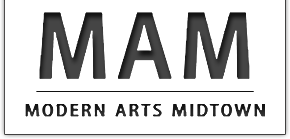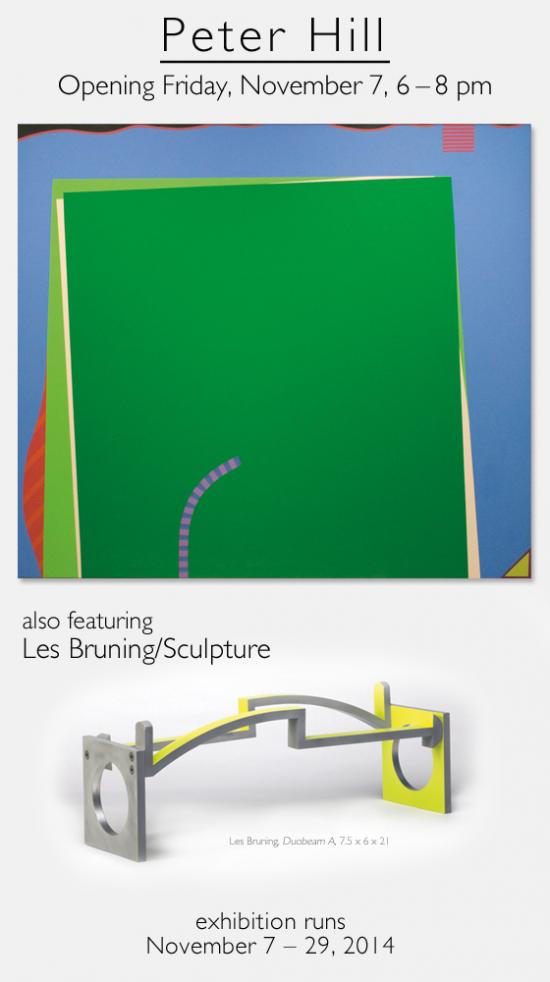Abstract Works: A survey of Peter Hill’s hard-edged geometric painting including new work from sculptor Les Bruning.
A new exhibition at Modern Arts Midtown reminds its patrons that many well-known and respected regional arts professors and instructors are first and foremost artists themselves. The best of them are fine studio creators of painting, sculpture, works on paper, textiles and new media. They teach by example. They practice what they preach.
This is certainly the case with MAM’s November exhibit that features a survey of Peter Hill’s hard-edged abstract painting from 1982-2014. Hill was an influential Professor of Art and Art History at the University at Omaha for 42 years, and although he retired in 2000, he has continued to paint a form of refined abstraction based upon a dynamic balance of geometric form and space and color relationships. It’s an adherence to his aesthetic that influenced many students and peers alike including fellow artist-instructors Gary Day and Colin Smith.
“Peter has managed to keep with essentially the same body of work ever since I met him,” said Day, a new media artist and Director of UNO Print Workshop. “He’s still interested in the possibilities of form and color and what he can do with them.” Smith, a painter, sculptor and UNO studio arts instructor, adds that Hill’s work “never loses its appeal,” due in large part not only to the “physical retinal response to his color interaction but to its playfulness as well.”
Yet, Smith is quick to point out that Hill’s influence as a mentor is due to his emphasis on “professionalism and craftsmanship” regardless of one’s style and subject matter. Day agrees, saying “He would tell them (students) they had to work all across the painting at least three times in order to get to a finished state.”
Hill’s 20 abstract paintings in this exhibit readily reflect not only a sophistication and polish, but also something else that belies, yet enhances their precision. Despite the assumption that geometric abstraction may lack the gestural spontaneity of “raw” abstraction, the artist’s interplay and interdependence of color, line and shape achieves a kinetic tension of its own based upon its asymmetrical balance and complementary palette. Hill achieves a marvelous, if uneasy, harmony that even he pokes fun at with his work titled “What’s wrong with this painting?”
This exhibit also includes sculpture from another influential area artist, mentor and instructor, Les Bruning. A former Chairman of Bellevue University’s Art Department and a significant regional public artist, Bruning will show primarily new work described as sculptural “drawings in space,” constructed with repeating aluminum elements. Works such as “Duocross,” “Duobeam” and “Tryblue” demonstrate a stately elegance and refined balance in keeping with Hill’s form of abstraction.
MAM director and artist Larry Roots calls these pieces “a remarkable and exciting new direction for Bruning,” while commenting further on this exhibit’s subjects and scope:
The painting of Peter Hill and the sculpture of Les Bruning are the substance of geometric abstraction which has endured in appreciation since its origins in the early 20th century and thrives currently in its association with the current “retro-look” in furniture and design.
With abstraction forerunners as Kandinsky, Josef Albers, Robert Mangold and Alexander Calder, we find foundation for the work of Peter Hill, Les Bruning and other fellow MAM Artists who emulate this “Cool Abstraction.”
Coined “Cool Abstraction” in prior MAM exhibitions, this work is not the explosive raw paint-laden abstraction of the expressionists but rather a discipline of simplified sophistication limited to line, color, geometry and composition. The two forms of abstraction are nonobjective (avoids reference to people, place or things) and require much more of the artist to explore new visual content of the mind. However, contrasts may be described as cool vs. hot, calculated vs. emotional, precision vs. instinctive, minimal vs. excessive, contained vs. explosive, refined vs. raw, etc.
– Michael J. Krainak, writer in the visual arts

